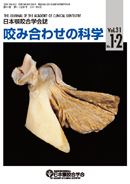Volume 31, Issue 1-2
Displaying 1-14 of 14 articles from this issue
- |<
- <
- 1
- >
- >|
Original papers
-
2011Volume 31Issue 1-2 Pages 12-20
Published: August 30, 2011
Released on J-STAGE: January 14, 2014
Download PDF (11240K) -
2011Volume 31Issue 1-2 Pages 21-27
Published: August 30, 2011
Released on J-STAGE: January 14, 2014
Download PDF (25725K) -
2011Volume 31Issue 1-2 Pages 28-41
Published: August 30, 2011
Released on J-STAGE: January 14, 2014
Download PDF (35684K)
Case report
-
2011Volume 31Issue 1-2 Pages 42-57
Published: August 30, 2011
Released on J-STAGE: January 14, 2014
Download PDF (15098K) -
2011Volume 31Issue 1-2 Pages 58-75
Published: August 30, 2011
Released on J-STAGE: January 14, 2014
Download PDF (13927K) -
2011Volume 31Issue 1-2 Pages 76-84
Published: August 30, 2011
Released on J-STAGE: January 14, 2014
Download PDF (4456K) -
2011Volume 31Issue 1-2 Pages 85-99
Published: August 30, 2011
Released on J-STAGE: January 14, 2014
Download PDF (17627K) -
2011Volume 31Issue 1-2 Pages 100-105
Published: August 30, 2011
Released on J-STAGE: January 14, 2014
Download PDF (5994K) -
2011Volume 31Issue 1-2 Pages 106-113
Published: August 30, 2011
Released on J-STAGE: January 14, 2014
Download PDF (10418K) -
2011Volume 31Issue 1-2 Pages 114-118
Published: August 30, 2011
Released on J-STAGE: January 14, 2014
Download PDF (1876K) -
2011Volume 31Issue 1-2 Pages 120-121
Published: August 30, 2011
Released on J-STAGE: January 14, 2014
Download PDF (22350K) -
2011Volume 31Issue 1-2 Pages 122-125
Published: August 30, 2011
Released on J-STAGE: January 14, 2014
Download PDF (1956K) -
2011Volume 31Issue 1-2 Pages 126-129
Published: August 30, 2011
Released on J-STAGE: January 14, 2014
Download PDF (2372K) -
2011Volume 31Issue 1-2 Pages 130-133
Published: August 30, 2011
Released on J-STAGE: January 14, 2014
Download PDF (16K)
- |<
- <
- 1
- >
- >|
